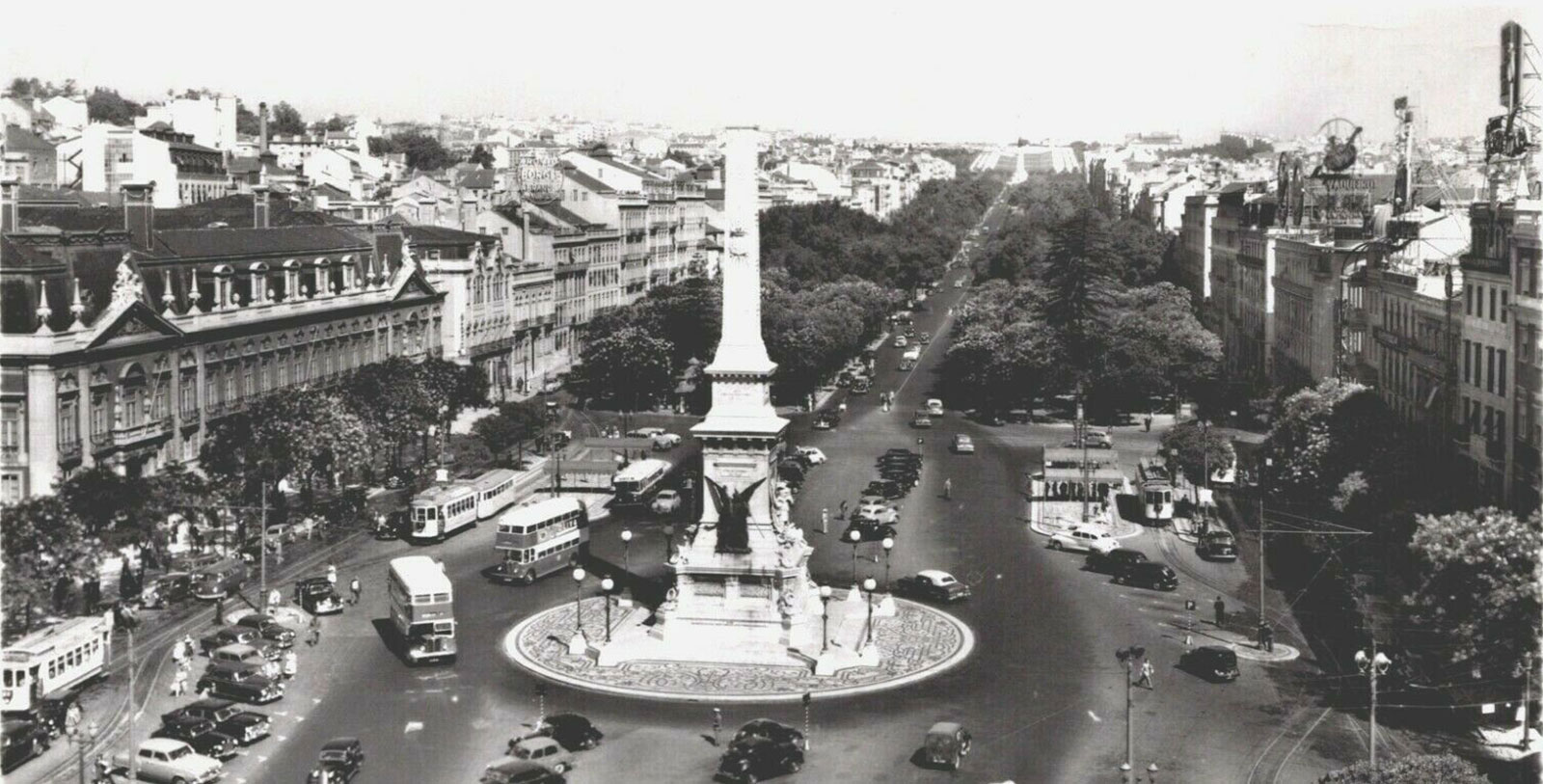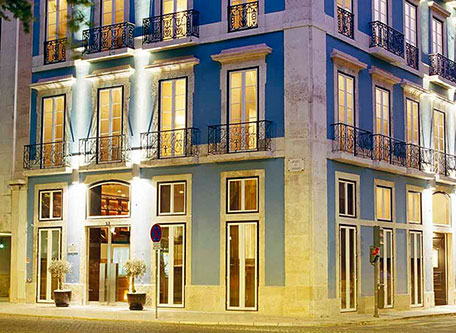Receive for Free - Discover & Explore eNewsletter monthly with advance notice of special offers, packages, and insider savings from 10% - 30% off Best Available Rates at selected hotels.
history
Discover Heritage Avenida Liberdade, which dates back to the 18th century when it was part of a regal palace.
Heritage Avenida Liberdade, a member of Historic Hotels Worldwide since 2022, dates back to the 18th century.
VIEW TIMELINELocated along Lisbon’s main historic thoroughfare, the Avenida da Liberdade, the Heritage Avenida Liberdade offers its guests a truly memorable vacation experience. This brilliant building dates back to the 18th century when it was originally part of a regal palace owned by the illustrious Ericeiras family. At the time of its debut, the surrounding area had been devastated following a destructive earthquake that affected Lisbon a few years prior. Committed toward revitalizing the city’s stunning beauty, Pombaline architect Reinaldo Manuel crafted a gorgeous public park that featured all kinds of luxurious fountains and statues. Inspired citizens eventually built structures like the future Heritage Avenida Liberdade in order to be closer to the neighborhood’s newfound beauty. The size of the region grew exponentially over the following decades, which attracted even more palatial manors to open nearby. In fact, the arrival of so many people prompted the municipal government to construct the Avenida da Liberdade in the late 19th century. Indeed, the newly created roadway and the historic mansions made the area feel as if it were an actual Parisian district. That historic atmosphere has endured ever since, making the Avenida da Liberdade one of the most popular places to visit in all of Lisbon. Lisbon Heritage Hotels sought to capture the same feeling when it began renovating the Heritage Avenida Liberdade into a wonderful boutique hotel during the 2000s. Indeed, the main architect in charge of spearheading the renovation was Miguel Câncio Martins, an accomplished architect best known for his work renovating large tracts of the Avenue des Champs-Élysées. His work succeeded in preserving much of the building’s original architecture, too, including its Pombaline tiles, veranda railings, and iron-wrought window shutters. The Heritage Avenida Liberdade has since become a popular holiday destination, especially among cultural heritage travelers. They have specifically enjoyed its luxurious amenities, outstanding historical architecture, and proximity to many famous landmarks like the Avenida da Liberdade. (The Avenida da Liberdade is also a significant contributing area to Lisbon’s renowned UNESCO World Heritage Site.)
-
About the Location +
While Lisbon today is among the most historic metropolises in Europe, its origins are a bit of a mystery. Historical evidence is scant regarding its founding, although recent archeological findings suggest the region was inhabited as far back as the Iron Age. Additional excavations in the heart of Lisbon have uncovered more artifacts that indicate a Phoenician presence dating back to the 12th century B.C. Those objects have enabled scholars to determine that Lisbon most likely formed as a Phoenician trading post that existed under the name “Olisipo.” Even though no record specifically cites the reasoning behind the title, some think that it was an homage to the legendary Greek hero Odysseus. Nevertheless, historians further believe that the village gradually grew into a massive city called “Felicitas Julia” following the Roman conquest of the Iberian Peninsula. The community served as the main bastion of power for the Roman Empire in the area, who developed imposing fortifications along the local waterway, the Tagus River. Those battlements specifically safeguarded the deep-water port at the river’s mouth, which had begun to flourish under Roman rule. But when the Roman Empire collapsed during the 5th century A.D., the settlement passed through various hands before finally getting captured by the Visigoths. They, in turn, lost control of the city to the Moors several centuries later. The Moors subsequently reinforced the city’s defenses, transforming the locale into an imposing bastion against European knights who wished to take it back. Their work reinforcing Lisbon was masterful, as the fortifications were able to blunt numerous attacks for decades.
In 1147, the Moorish defenses were put to the ultimate test when the Portuguese king Afonso I attempted to seize the city amid the Second Crusade (and the greater Portuguese Reconquista). At the head of a massive army, Afonso I managed to wrestle control from the Moors following a dramatic four-month-long siege. Now known as “Lisbon,” the city quickly emerged as an important commercial center in the nascent Kingdom of Portugal. Despite its rising economic status, the Portuguese Royal Family held its official court several hundred miles away in Coimbra. But King Afonso III decided to relocate the royal residence to Lisbon in the mid-13th century, thus making it the capital for the entire kingdom. Lisbon thrived due to its newfound political significance, with successive generations of Portuguese monarchs investing heavily into its continued development. Some of the most notable projects involved King Dinis I’s creation of the Studium Generale and the massive renovations that King Fernando I did to the ancient Castelo de São Jorge. Perhaps the greatest work to transpire occurred during the reign of King Manuel I, who oversaw the widespread urbanization of Lisbon. Among the best structures that he commissioned at the time included the Torre de Belém (Belém Tower) and the Paço da Ribeira (Ribeira Palace). Manuel had obtained much of the wealth to finance the construction via the great riches that had begun to flow into Lisbon’s harbor from Portugal’s newly created distant colonies. The amount of trade conducted became so great that Lisbon eventually established itself as one of Europe’s greatest cities by the end of the 16th century.
This renaissance came to an unfortunate end when a massive earthquake caused catastrophic damage throughout the city in 1755. Undeterred, the local residents banded together to rebuild most of Lisbon in a matter of years. Spearheading the revitalization efforts was Sebastião José de Carvalho, Portugal’s prime minister. He worked closely with a team of architects to redesign much of Lisbon’s historic districts, creating many new buildings in a simple, yet gorgeous style of Baroque architecture that became known as “Pombalino.” (The moniker was an homage to Carvalho, whose royal title was the Marques de Pombal.) Lisbon resumed its place as a prominent European community for many years, even as war, political instability, and economic depression periodically impacted Portugal in the 19th and 20th centuries. In fact, the city only continued to grow, as epitomized by the creation of a magnificent new thoroughfare that bisected the heart of Lisbon called the “Avenida da Liberdade.” (The boulevard specifically debuted at the height of Europe’s Belle Epoque period in the 1890s.) Following the country’s integration into the European Union at the start of the 21st century, Lisbon has solidified its standing as an elite, internationally renowned metropolis. Its rich character has inspired thousands of contemporary travelers to visit every year, placing it on par with other popular destinations throughout the Mediterranean Basin like Venice and Rome. Indeed, Lisbon’s many fascinating historic sites—including the Torre de Belém, the Paço da Ribeira, and the Castelo de São Jorge—have been essential toward maintaining this incredible international interest. Most of those historic sites have also contributed to the creation of Lisbon’s spectacular UNESCO World Heritage Site, which encompasses large tracts of its downtown core.
-
About the Architecture +
Heritage Avenida Liberdade displays some of the finest Classical Revival architecture in Lisbon, specifically a unique Portuguese subset known as “Pombaline.” Also known as “Neoclassical,” Classic Revival architecture itself is among the most common architectural forms seen throughout the world today. This wonderful architectural style first became popular in Paris, especially among French architectural students that studied in Rome in the 18th century. Upon their return, the architects began emulating aspects of earlier Baroque design aesthetics into their designs, before finally settling on Greco-Roman examples. Over time, the embrace of Greco-Roman themes spread across Europe, reaching destinations like Germany, Spain, and Great Britain. The specific “Pombaline” subset emerged in Portugal following the devastating Earthquake of 1755. The calamity had thoroughly destroyed much of downtown Lisbon, creating a residential housing crisis that affected much of the population. To find a solution, the Portuguese Prime Minister, Sebastião José de Carvalho e Melo, the first Marquês de Pombal, organized a government engineering team to reconstruct the heart of Lisbon. Manuel da Maia specifically oversaw all the work, redesigning the city’s irregular, medieval street grid for one favoring an orthogonal layout. Maia then coordinated with two other engineers— Eugénio dos Santos and Carlos Mardel—to craft the appearances of the new buildings slated to open along the rebuilt thoroughfares.
Unlike most other largescale European building projects, the construction undertaken by the Marquês de Pombal’s team created prefabricated, structurally sound edifices that were both durable and quick to produce. Indeed, most of the new buildings were originally constructed outside the city in individual parts and assembled on their respective lots. Due to a tight construction schedule and limited funds, the architects also used a more streamlined version of the popular Neoclassical aesthetic that were dominating the continent at the time. As such, most of the structures showcased similar designs featuring ground-level arcades and balconies on both ends of the structure. Every building also had a flexible wooden frame that could withstand external pressure and separate walls to prevent fire damage. At most, the new buildings also went as high as four stories to ensure a uniform appearance. While the architects allowed for some variance with exterior ornamentation, budgetary constraints meant that the buildings generally possessed comparable details. The architectural style thus relied upon restricted use of Neoclassical motifs like the symmetrical placement of doors and windows, as well as the use of a classical pediment. The new design gradually assumed its own identity, too, with local residents throughout Lisbon calling it “Pombaline.” Pombaline has since remained the most iconic form of Portuguese architecture in the city today. In fact, the architectural style played an instrumental role in getting the community’s historic core identified as a UNESCO World Heritage Site by the United Nations!
In recent years, Lisbon Heritage Hotels undertook a significant renovation that sought to restore the building’s architectural heritage. Miguel Câncio Martins specifically spearheaded the effort, whose interventions in the most cosmopolitan capitals stand out for their daring and creativity. His work managed to rehabilitate its stunning blue façade for future generations to appreciate. He recreated the hues of yellow and brown that once defined the interior layout, although the junior suite in the mansard were an exception. Martins’ team also installed sloping windows outlined in silver and anthracite that granted guests the ability to clearly see the beauty of downtown Lisbon. Indeed, the building’s ashlar, veranda railings, main wooden door, and shutters with the original iron fittings all received considerable attention throughout the project. Even the hotel’s historic Pombaline tiles were carefully restored after great effort, as well as its recovered herbalist counter near the entrance. (That area now functions as a tea service station.) Lisbon Heritage Hotels placed historical photographs of Lisbon throughout the building’s 42 guestrooms to complement the restoration, too. Engravings of quotes from renowned Portuguese poets like Fernando Pessoa and António Gedeão provided further immersive visual elements, as did brand new works of art designed exclusively for the hotel by reputed Iranian artist Chayan Khoï. The work has since thoroughly engrossed guests into the fantastic historical culture of Lisbon. Perhaps the best testimony to this accomplishment is one of Pessoa’s inscribed quotes on the spiral staircase, which reads: “The world was not made to be thought about, but rather to look at it and to be in harmony.”


























